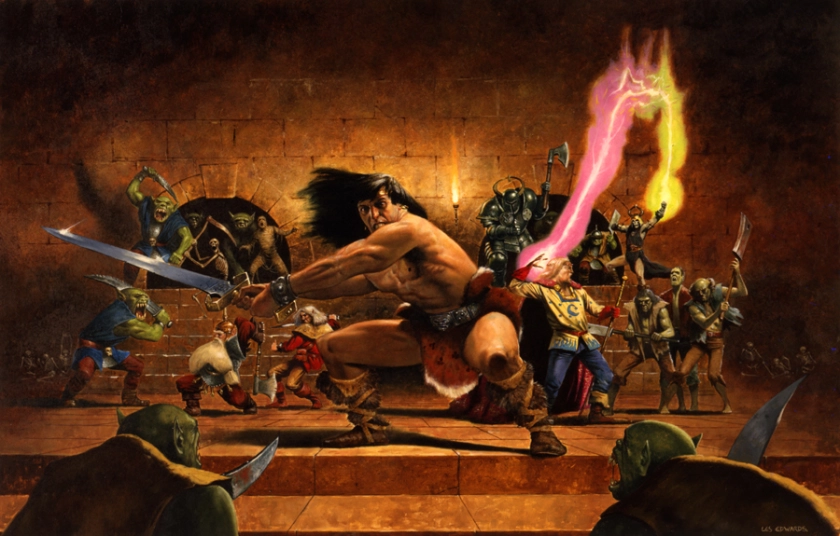The Orc-infested dungeons of Zargon (or Morcar) would never be called hospitable, but even the disgusting hordes of green-skinned minions need a place to eat, relax, and prop their boots after a long day of evil-doing. For this purpose, every HeroQuest box was graced with two glorious wooden tables.
As with the torture rack, each of these pieces of furniture come with two molded plastic ends between which a piece of folded cardboard is placed (with a plastic spacer between the ends like a misshapen dumbbell). For my upgraded version, I simply replaced the cardboard with a simple set of wooden planks made out of styrene plastic.
Following this quick and dirty assembly, the only thing left to do was slap on some paint. Since I have such a reverence for the original game components, I attempted to match the color and pattern of wood grain as closely as I could for the first table. The planks of the tabletop appeared to be bound by bands of metal at each end. Being dungeon furniture, I imagined this metal would be poorly maintained, raw steel, rather than anything flashy or polished. One might imagine a lot of rust on this type of metal, but I was concerned that this would not contrast well with the very reddish color of the wood, so I chose to try mimicking cast iron. I found this metal much more difficult to render than regular gold or steel, however, since my normal non-metallic metal technique relies heavily on bright reflections and highly contrasted shadows. The first passes had very nice gradients, but came off rather flat. The addition of scratches helped somewhat, but it was only with the addition of some nails going into each plank that any resemblance to actual metal was achieved. These details allowed me to add some highlights and shades within areas that would otherwise have been featureless, helping to sell the illusion of metal.
Since the wood-grain on the two stock inserts was very similar (in fact, I believe it was just a mirror image), I decided to have a little fun with the second table to set it apart. It is hard to do anything very original with a game that has been around for nearly thirty years, so my attempts pale in comparison to some of the more creative modifications that can be found online (my favorite being a printed insert with a miniature HeroQuest board and Evil Wizard Screen, which can be seen here). Alas, my imagination rarely strays beyond my belly, so food was the only logical addition I could come up with.
The plate, steak, mug, and bowl were all made from styrene. For the plate, I cut a rough circle out of 0.040 sheet styrene, drilled a hole in the center, and attached it to a rotary tool. While the tool was spinning, I used several files to round out the edges and a hobby knife to form the concave recess in the center. The mug and bowl were both made from 0.250 styrene rod, which I chucked into my drill press and carved, at speed, with a razor blade, file, and a flat topped drill bit. The soup, spilled beer, and peas were all made out of some Aves Apoxieput.
They may not be all that exciting, but I’m pretty happy with what I was able to accomplish with both versions of the table. Let me know what you think, and stay tuned for some more furniture in the coming months.
Wood:
VCM Black (70.950) for the cracks. Base coated in VMC Mahogany Brown (70.846). The main pattern for the wood grain was painted in with a layer of 1:1 Mahogany Brown and VMC Orange Brown (70.981). Some variation was added with slightly more Mahogany Brown or Orange Brown to this mix, before edge highlighting with pure Orange Brown. Cracks and knotholes were added with a 1:2 mix of Black and Mahogany Brown. Fine point highlights of 1:2 Orange Brown and VMC Dark Sand (70.847) were added to edges and points of wood grain.
Wrought Iron:
Base coated with a 2:1 mix of VMC Black Grey (70.862) and VMC Dark Sea Blue (70.898). A minimalistic NMM effect was created with the progressive addition of white to this mix, with the final highlight being a 1:1 mix of the base tone and VGC Dead White (72.001). The addition of some VMC Black (70.950) was added to the base mix for selective darkening (such as in the “chips” along the sides, as well as at the edges opposite the brightest parts of the blends). Finally, some very small point highlights with a 1:2 mix of the base tone and Dead White.
Table Settings:
Wood (Plate, Mug, and Bowl):
Base coated with 1:1 mix of VMC Flat Earth (70.983) and VMC Japan Unif. WWII (70.923), which served as the dark grain. The lighter sections of grain were a 1:2 mix of the same colors, with pure Japan Unif. WWII for selective highlights.
Metal (Spoon and rims of mug):
Standard nonmetallic metal with VMC Black (70.950) and VMC Green Grey (70.971).
Beer:
The base coat was a 1:1 mix of VGC Scrofulous Brown (72.038) and VMC Yellow Ochre (70.913). This was left around the downturned edges of the puddle. The upper surface was then covered with pure Yellow Ochre, which was blended out to the edges. The reflection and step-off at the mug received highlights of 1:1 mix of Yellow Ochre and Schmincke Titanium White.
Steak:
The meat was base coated with a 1:1 mix of VMC German Camo Black Brown (70.822) and VMC Scarlet (70.817). The lighter areas (bone and fat) were highlighted with the inclusion of VMC Japanese Uniform WWII (70.923) to the original mix.















Awesome job Tom. Love your attention to detail. IMO we don’t play Hero Quest enough. It will always be my first love when it comes to tabletop.
LikeLiked by 1 person